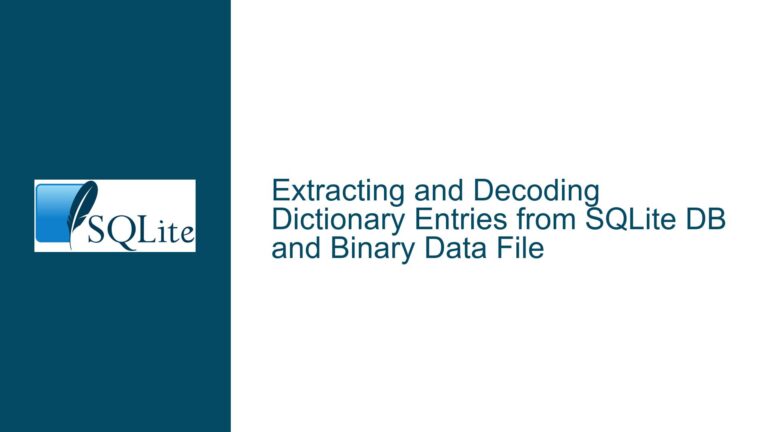Heap Buffer Overflow in SQLite’s re_subcompile_string Function
Heap Buffer Overflow in re_subcompile_string Function During Regex Compilation
The issue at hand involves a heap buffer overflow occurring in the re_subcompile_string function within SQLite. This function is part of the regex compilation process, specifically when handling a complex regular expression pattern. The overflow manifests when SQLite attempts to compile a regex pattern that exceeds the allocated memory buffer, leading to a write operation outside the bounds of the heap-allocated memory region. This results in a critical memory corruption issue, which can cause unpredictable behavior, including crashes or security vulnerabilities.
The problem is triggered by a specific sequence of SQL commands, which includes creating a table, defining an index with a regex pattern, setting a hard heap limit, and inserting data into the table. The regex pattern in question is exceptionally long and complex, pushing the re_subcompile_string function to its limits. The AddressSanitizer (ASAN) report indicates that the overflow occurs during a write operation of size 4 at a memory address just beyond the end of a 960-byte region allocated on the heap. This overflow is a direct consequence of insufficient memory allocation for the regex pattern during the compilation phase.
Insufficient Memory Allocation and Regex Pattern Complexity
The root cause of the heap buffer overflow lies in the insufficient memory allocation for the regex pattern during the compilation process. The re_subcompile_string function is responsible for compiling regex patterns into an internal representation that SQLite can use for pattern matching. When the regex pattern is exceptionally long and complex, the function attempts to resize the allocated memory buffer to accommodate the pattern. However, due to a miscalculation or oversight in the memory allocation logic, the buffer is not resized sufficiently, leading to a write operation that exceeds the allocated memory bounds.
The regex pattern in question contains a large number of repeated characters and a specific character class ([0]), which adds to the complexity of the pattern. The re_subcompile_string function processes this pattern by appending characters to the internal buffer, but the buffer’s size is not adjusted correctly to handle the pattern’s length. As a result, when the function attempts to write the compiled regex data, it overflows the buffer, causing the heap buffer overflow.
The issue is exacerbated by the PRAGMA hard_heap_limit=90000 command, which restricts the total heap memory available to SQLite. This limitation forces SQLite to operate within a constrained memory environment, increasing the likelihood of memory allocation failures or insufficient buffer sizes. When combined with the complex regex pattern, the hard heap limit amplifies the risk of a buffer overflow, as SQLite is unable to allocate additional memory to accommodate the pattern’s requirements.
Steps to Diagnose, Resolve, and Prevent Heap Buffer Overflows in SQLite
To diagnose and resolve the heap buffer overflow issue in SQLite’s re_subcompile_string function, follow these detailed steps:
Step 1: Reproduce the Issue
Begin by reproducing the issue using the provided SQL commands. Create a table, define an index with the problematic regex pattern, set the hard heap limit, and insert data into the table. Ensure that SQLite is compiled with AddressSanitizer (ASAN) enabled to detect memory issues. The ASAN report will provide detailed information about the heap buffer overflow, including the memory address, thread, and stack trace.
Step 2: Analyze the ASAN Report
The ASAN report indicates a heap buffer overflow during a write operation in the re_subcompile_string function. The report specifies that the overflow occurs at a memory address just beyond the end of a 960-byte region allocated on the heap. The stack trace reveals the sequence of function calls leading to the overflow, starting from re_subcompile_string and ending with the main function. Analyze the stack trace to understand the flow of execution and identify the point at which the buffer overflow occurs.
Step 3: Review the Memory Allocation Logic
Examine the memory allocation logic in the re_subcompile_string function. Focus on the re_resize, re_insert, and re_append functions, which are responsible for resizing the memory buffer, inserting data into the buffer, and appending data to the buffer, respectively. Identify any miscalculations or oversights in the buffer size calculations that could lead to insufficient memory allocation. Pay particular attention to how the buffer size is adjusted when handling long and complex regex patterns.
Step 4: Fix the Memory Allocation Logic
Modify the memory allocation logic to ensure that the buffer is resized correctly to accommodate the regex pattern. This may involve adjusting the buffer size calculations, increasing the initial buffer size, or implementing additional checks to prevent buffer overflows. Test the modified code with the problematic regex pattern to verify that the heap buffer overflow is resolved.
Step 5: Test with Different Regex Patterns
Test the modified SQLite code with a variety of regex patterns, including patterns of different lengths and complexities. Ensure that the memory allocation logic handles all patterns correctly and that no buffer overflows occur. Use ASAN to detect any memory issues during testing.
Step 6: Implement Additional Safeguards
Implement additional safeguards to prevent heap buffer overflows in the future. This may include adding bounds checking to the re_subcompile_string function, enforcing maximum limits on regex pattern lengths, or using safer memory allocation functions. Consider adding runtime checks to detect and handle memory allocation failures gracefully.
Step 7: Update Documentation and Best Practices
Update the SQLite documentation to include information about the heap buffer overflow issue and the steps taken to resolve it. Provide guidelines for using regex patterns in SQLite, including recommendations for pattern complexity and memory usage. Encourage users to test their regex patterns thoroughly and to use tools like ASAN to detect memory issues.
Step 8: Monitor for Future Issues
Monitor SQLite for any future issues related to memory allocation and buffer overflows. Stay informed about updates and patches from the SQLite development team, and apply them promptly to ensure that your SQLite installation remains secure and stable.
By following these steps, you can diagnose, resolve, and prevent heap buffer overflows in SQLite’s re_subcompile_string function, ensuring that your database operations remain secure and reliable.






